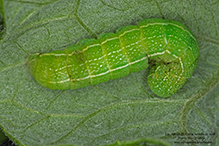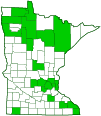Speckled green fruitworm moth
(Orthosia hibisci)
Conservation • Description • Habitat • Ecology • Distribution • Taxonomy
| Hodges # | 10495 |
||
Conservation Status |
|||
| IUCN Red List | not listed |
||
| NatureServe | NNR - Unranked |
||
| Minnesota | not listed |
||
Description |
Speckled green fruitworm moth is an early season, medium-sized owlet moth. It occurs throughout the United States and southern Canada. It has been reported in every state except Florida. It is common in Minnesota. Adults are found from late March to late May in deciduous woodlands and forests, parks, and fruit orchards. It is one of the first adult moths to emerge in the spring. Mature larvae (caterpillars) are active from late March to late May on the early growth of a wide variety of deciduous trees and shrubs, including alder, apple, ash, autumn olive, cherry, chokecherry, crabapple, elm, gooseberry, hickory, maple, oak, plum, poplar, and willow. It has also been found on spruce. Adults are ¾″ to ⅞″ (20 to 23 mm) long and have a wingspan of 1¼″ to 1⅝″ (32 to 42 mm). The forewing is grayish-brown with distinct lines and spots and little to a moderate amount of brown or reddish-brown mottling. They are sparsely to moderately peppered with dark scales. There is a circular (orbicular spot) spot in the upper median area and a kidney-shaped spot (reniform spot) at the end of the discal cell. Both spots are large, bordered with white, and the same color as the ground in the center. The reniform spot has a conspicuous black spot in the inner half. There is no club-shaped spot (claviform spot) between the orbicular spot and the inner margin. There are several dark wavy lines, including the basal line in the basal area; the antemedial (AM) line between the basal and median areas; the median line which passes through the median area; the postmedial (PM) line that separates the median area from the postmedial area; the terminal line at the outer margin; and the subterminal (ST) line, between the PM line and the terminal line. The basal line is reddish-brown but is usually covered by the a tuft of hairs on the top of the thorax. The AM line is reddish-brown and broadly curved downward. It is sometimes indistinct or even absent. The median line is broad, dark in the center, and diffuse on the edges. It is strongly curved downward in the middle into the reniform spot and upward approaching the inner and leading (costal) margin. The PM line is scalloped and consists of a series of dark dots. The ST line is conspicuous, thin, pale, and slightly curved downward in the middle. The terminal line consists of a line of black dots, one at the end of each cell. The fringe is dark. The hindwings are grayish-brown with a dark discal spot. They are sparsely to moderately peppered with dark scales. The fringe is pale. The head and thorax are the same color as the forewings. On the upper side of the thorax there is a tuft of hairs that is variably light, dark, or light grading to dark. The antennae are threadlike on both the male and the female. Late stage (instar) caterpillars are 1 3 ⁄16″ to 1 9 ⁄16″ long and light green or bluish-green. They have abundant creamy-white speckling; a broad, white, continuous, longitudinal stripe down the middle (middorsal stripe) bordered with thin, medium green lines; and a thin, broken, white line in the subdorsal area on each side. The breathing pores (spiracles) are pale with very thin black rims. A conspicuous white line runs above the spiracles on the first through seventh abdominal segments (A1 through A7) and below the spiracles on A8 and the first segment of the thorax (T1). The head is pale green and unmarked except for a pale crescent running through each eye. |
Size |
Total length: ¾″ to ⅞″ (20 to 23 mm) Wingspan: 1¼″ to 1⅝″ (32 to 42 mm) |
Similar Species |
Habitat |
Deciduous forests and woodlands, parks, fruit orchards |
Ecology |
Season |
One generation per year: late March to late May |
Behavior |
Adults are active at night and will come to lights. |
Life Cycle |
Pupa overwinter |
Larva Hosts |
Early growth of a wide variety of deciduous trees and shrubs, including alder, apple, ash, autumn olive, cherry, chokecherry, crabapple, elm, gooseberry, hickory, maple, oak, plum, poplar, and willow. It has also been found on spruce. |
Adult Food |
|
Distribution |
||
|
Sources 21, 24, 29, 30, 71, 75, 82, 83. Biodiversity occurrence data published by: Minnesota Biodiversity Atlas (accessed through the Minnesota Biodiversity Atlas Portal, bellatlas.umn.edu, 9/1/2025). |
|
| 9/1/2025 | ||
Occurrence |
||
Widespread and abundant |
||
Taxonomy |
|
Order |
Lepidoptera (Butterflies and Moths) |
Superfamily |
Noctuoidea (Owlet Moths and Allies) |
Family |
Noctuidae (cutworm moths and allies) |
Subfamily |
Noctuinae (cutworms and dart moths) |
Tribe |
Orthosiini |
Genus |
Orthosia |
Subordinate Taxa |
|
|
|
Synonyms |
|
Orthosia brucei Orthosia confluens Orthosia inflava Orthosia inherita Orthosia insciens Orthosia latirena Orthosia malora Orthosia nubilata Orthosia proba Orthosia quinquefasciata |
|
Common Names |
|
green fruitworm speckled green fruitworm (caterpillar) speckled green fruitworm moth (adult) |
|
Glossary
Antemedial (AM) line
A thin line separating the basal area and the median area of the forewing of Lepidoptera.
Costal margin
The leading edge of the forewing of insects.
Instar
The developmental stage of arthropods between each molt; in insects, the developmental stage of the larvae or nymph.
Orbicular spot
A circular spot or outline in the upper median area near the antemedial line on the forewing of many moths.
Postmedial (PM) line
A thin line separating the median area and the postmedial area of the forewing of Lepidoptera.
Reniform spot
A kidney-shaped spot or outline in the lower median area near the PM line on the forewing of many moths.
Spiracle
A small opening on the surface of an insect or arachnid through which it breathes.
Visitor Photos |
Share your photo of this insect. |
||
This button not working for you? |
||
Alfredo Colon |
 |
MinnesotaSeasons.com Photos |
|

Slideshows |
|

Visitor Videos |
Share your video of this insect. |
||
This button not working for you? |
||
|
Other Videos |
Speckled Green Fruitworm Moth (Noctuidae: Orthosia hibisci) |
About
Apr 18, 2011 Photographed at Fisher, Minnesota (18 April 2011). Go here to learn more about this species: http://tfrec.cahnrs.wsu.edu/ |
Speckled Green Fruitworm Moth (Noctuidae: Orthosia hibisci) |
About
May 1, 2010 Photographed at Grand Forks, North Dakota (30 April 2010). |
Speckled Green Fruit-worm ~ Orthosia hibisci (Guenée) |
About
Jun 2, 2014 Life history There is one generation per year. The speckled green fruit-worm overwinters as a pupa in the soil. Adults emerge from March to May and lay eggs on tree leaves. Larvae begin to hatch in April and climb to the tips of limbs and spurs where they feed and grow. They prefer fruiting spurs and often conceal themselves by webbing the leaves together with silk. They feed at first on buds, then later on flowers, leaves and fruit. In summer, mature larvae drop to the ground and burrow into the soil to pupate. Life stages Speckled green fruitworm larva (F. Howell) Egg: The egg is pale gray when first laid. It is spherical with a flat base where it is cemented to the plant. It has 40 to 48 ribs and is 1/30 inch (0.8 mm) in diameter. After a day or two, purple blotches appear around the micropyle and the shoulder. Larva: The larva develops through six instars and measures between 1 and 1-2/3 inches (25 to 41 mm) long when mature. It is green with five white stripes the length of the body (Figure 63). The head is brown at first but gradually turns green. Adult: The adult is a nondescript, reddish-brown moth about 3/4 inch (19 mm) long. |

|
Created: 12/16/2019 Last Updated: © MinnesotaSeasons.com. All rights reserved. |


